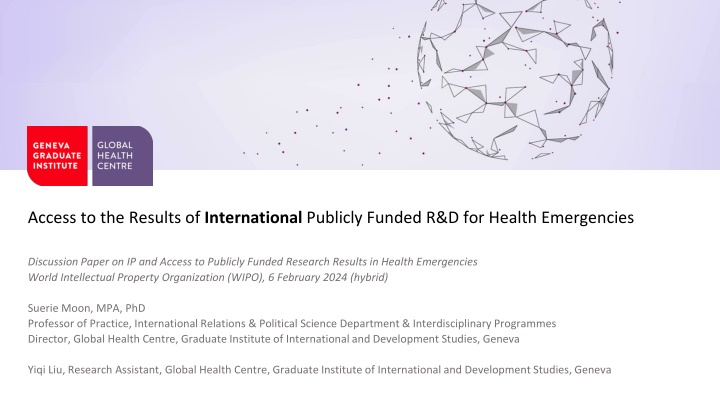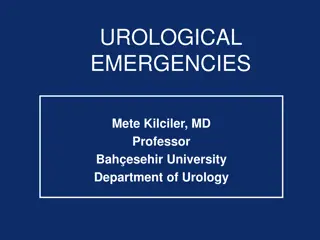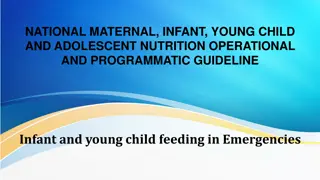Access to the Results of International Publicly Funded R&D for Health Emergencies
Discussion paper on IP and access to publicly funded research results in health emergencies presented by WIPO, focusing on the role of the public sector in driving health emergency R&D, access conditions for international projects, and growing capacity in LMICs. Key points include leveraging public funding, tying conditions to funding, open access publication, pricing and supply commitments, and transparency efforts.
Download Presentation

Please find below an Image/Link to download the presentation.
The content on the website is provided AS IS for your information and personal use only. It may not be sold, licensed, or shared on other websites without obtaining consent from the author.If you encounter any issues during the download, it is possible that the publisher has removed the file from their server.
You are allowed to download the files provided on this website for personal or commercial use, subject to the condition that they are used lawfully. All files are the property of their respective owners.
The content on the website is provided AS IS for your information and personal use only. It may not be sold, licensed, or shared on other websites without obtaining consent from the author.
E N D
Presentation Transcript
Access to the Results of International Publicly Funded R&D for Health Emergencies Discussion Paper on IP and Access to Publicly Funded Research Results in Health Emergencies World Intellectual Property Organization (WIPO), 6 February 2024 (hybrid) Suerie Moon, MPA, PhD Professor of Practice, International Relations & Political Science Department & Interdisciplinary Programmes Director, Global Health Centre, Graduate Institute of International and Development Studies, Geneva Yiqi Liu, Research Assistant, Global Health Centre, Graduate Institute of International and Development Studies, Geneva
3 key ideas Public sector drives health emergency R&D Access conditions the norm for international R&D projects for health emergencies Growing LMIC R&D and production capacity
Public sector role: Intensive and Extensive Emerging Infectious Disease (EID) R&D Inter-pandemic times: Unclear if, when & how much product needed Very high risk Public sector drives R&D
3 key ideas Public sector drives health emergency R&D Access conditions the norm for international R&D projects for health emergencies Growing LMIC R&D and production capacity
Public funding an important tool for leverage Tying conditions to funding: a common, proven practice to improve access to fruits of R&D in international projects for health emergencies Open access publication and sharing of data and study results Pricing commitments Supply commitments Funder retention of IP and other rights Transparency
3 key ideas Public sector drives health emergency R&D Access conditions the norm for international R&D projects for health emergencies Growing LMIC R&D and production capacity
From 2010-20, number of trials in LMICs increased by 375%. Source: Vieira et al (2023). Rising pharmaceutical innovation in the Global South: a landscape study | Journal of Pharmaceutical Policy and Practice | Full Text (biomedcentral.com)
2022 snapshot: A global system of Covid-19 vaccine R&D Developer Top 10 trial locations US China Australia Brazil Japan South Africa Canada Germany Indonesia Iran South Korea Turkey Argentina India Russia Thailand UAE UK HICs LMICs HICs+LMICs Development stage Number of candidates 1 2 3 4 5 6 7 35 32 21 16 13 12 11 9 9 8 8 8 7 7 7 7 7 7 Pre-clinical 199 55% 39% 6% Clinical 172 53% 41% 6% Total in 371 development 8 Total approved 50 9 10 Source: Luana Bermudez data analysis for the Global Health Centre. Data sources: WHO and LSHTM Covid-19 vaccine trackers
3 key ideas Public sector drives health emergency R&D Access conditions the norm for international R&D projects for health emergencies Growing LMIC R&D and production capacity
Case studies of International R&D Projects for Health Emergencies 1. CEPI - Novavax COVID-19 Vaccine (NVX-CoV2373) Project 2. Unitaid - FIND Hepatitis C Diagnostics Project 3. GARDP - Entasis Novel Antibiotic for Gonorrhea (Zoliflodacin) Project 4. International Collaboration on Ebola Vaccine (rVSV-ZEBOV) 5. Baylor - Biological E COVID-19 vaccine (Corbevax) Project
Case 1: CEPI - Novavax COVID-19 Vaccine (NVX-CoV2373) Project Operational Model Public Funding (CEPI s donors) IP Management Novavax has IP ownership. In general, CEPI does not take IP ownership, except through a Public Health License . CEPI Novavax Funding from the US government (pre-COVID)
Case 1: CEPI - Novavax COVID-19 Vaccine (NVX-CoV2373) Project Progress of the Project Dec 2021, NVX-CoV2373 was granted the WHO EUL. Feb 2021, Novavax committed 1.1 billion doses to COVAX through Gavi. The agreement was terminated in Nov 2022, reportedly due to difficulties in the rollout of the vaccine on Novavax s side. Around 59 million doses sold, almost all to high-income countries via bilateral agreements. Discussion CEPI as an intermediary conditions to facilitate equitable access Acceptability of CEPI s conditions (and $$$): Smaller companies or academic institutions vs. some larger and more experienced firms. Global entities like CEPI are at a competitive disadvantage if large public donors do not have strings attached to their funding.
Case 2: Unitaid - FIND Hepatitis C Diagnostics Project Operational Model Public Funding (Unitaid s donors) IP Management FIND owned the IP, and the manufacturer would operate under an exclusive license, in exchange for appropriate pricing commitments in LMICs. Largely technical know-how, not patents FIND Contract developer (work for hire)
Case 2: Unitaid - FIND Hepatitis C Diagnostics Project Progress of the Project In 2019, FIND identified a suitable commercial partner and the product was originally expected to be available for manufacturing in mid-2020. The emergence of COVID-19 derailed (at least temporarily) the HCV project. As the need for COVID-19 diagnostics has ramped down, the cAg RDT may be picked up again for final stage development. Discussion Conditions on public funding can be leveraged in different ways. The relatively small market size for health tools targeting LMICs means that public funding is often necessary to drive R&D. Paying the full costs of R&D with public funds allowed FIND to retain full control of the IP, and then to leverage that control to offer a manufacturer a monopoly in exchange for global access commitments.
Case 3: GARDP - Entasis Novel Antibiotic for Gonorrhea (Zoliflodacin) Operational Model Public Funding (GARDP s donors) IP Management Entasis held patents on the active pharmaceutical ingredient for zoliflodacin. Entasis granted GARDP an exclusive and royalty-free license for use in the treatment of gonorrhea with sublicensing rights for manufacturing worldwide and for the sale and/or distribution in 168 countries or territories, covering all LMICs and a few HICs. Entasis retained rights in most HICs. GARDP Entasis Funding from the US government (for Phase I and II Clinical Trials)
Case 3: GARDP - Entasis Novel Antibiotic for Gonorrhea (Zoliflodacin) Progress of the Project Phase 3 trials completed in May 2023*. Zoliflodacin has been designated a Qualified Infectious Disease Product by the FDA and awarded a Fast Track status. GARDP has started initial discussions with potential partners to facilitate the commercialization and distribution of the product once it is developed. Discussion GARDP is in charge of the product distribution in LMICs, which would have not been considered a priority otherwise. An alternative approach to funding conditions and IP management, compared with the more common approach of attaching conditions and relying on the developers/manufacturers to ensure access in LMICs. The need to ensure both globally equitable access and responsible stewardship. * GARDP annonced positive results of the phase 3 trials in November 2023.
Case 4: International Collaboration on Ebola Vaccine (rVSV-ZEBOV) Key milestones and events during the development of rVSV- ZEBOV in the lead up to the 2014 2015 Ebola epidemic WHO & Additional public funding (Norway, UK, Canada, US, etc) Limited progress * Image reproduced from Herder et al (2020) under a Creative Commons license.
Case 4: International Collaboration on Ebola Vaccine (rVSV-ZEBOV) Operational Model Public Funding IP Management In Nov 2014, Newlink granted Merck exclusive rights to the vaccine and any follow-on products. It received US$ 50 million from the license. In the agreement, PHAC retained non-commercial rights on the vaccine candidate. No specific conditions on IP in the agreement between Merck and WHO. WHO Study Implementers (GSK, BPS) Funding from the US government and the Canadian governnent (prior to the 2014 outbreak)
Case 4: International Collaboration on Ebola Vaccine (rVSV-ZEBOV) Discussion This question of pricing, access, and IP management was always treated in the agreements that we [WHO] had with the industry. But not in an emergency. In an emergency, all this appeared secondary as there was no doubt that someone would fund the product once available. What is important is to try to push this down the line as quickly as possible. ---- Interview with Dr. Marie-Paule Kieny, former Assistant Director-General, WHO Very limited commercial interest in the R&D of the Ebola vaccine. Predominantly supported by the public sector for both R&D and procurement. It would be beneficial to agree in advance on the norms and principles that should govern such R&D contracts and to pre-negotiate contractual provisions to serve as a baseline for negotiation in a crisis.
Case 5: Baylor - Biological E Partnership on COVID-19 vaccine (Corbevax) Operational Model Funding from the Indian government IP Management The core technology has been well- known and available off-patent for many years. Open Access approach. During the COVID-19 pandemic, Baylor decided to not go through any IP protection process. Biological E Know-how Baylor Funding from the US government (pre-COVID)
Case 5: Baylor - Biological E Partnership on COVID-19 vaccine (Corbevax) Progress of the Project In Dec 2021, BioE received emergency use authorization for Corbevax in India. As of May 2023, around 84 million doses administrated in India. Baylor also licensed the vaccine in parallel to BioFarma in Indonesia, which successfully developed Indonesia s first Halal-certified domestically produced COVID-19 vaccine. Approximately 10 million doses were administered in Indonesia. Discussion How an open science approach could be adopted to facilitate global equitable access. The Baylor project did not receive large- scale public funding during the COVID-19 pandemic. One reason may be that funders did not consider the established protein technology at the beginning.
Summary of Examples Conditions on Funding and IP management Examples Conditions on Funding from Major Government Donors Conditions on Funding from Intermediaries and IP Management No specific conditions - Donors are involved in high-level decision-making through the Investor Council. (CEPI) Public Health License; affordable pricing; supply commitment to a global distribution entity; publication of data and study results. Case 1: CEPI - Novavax COVID- 19 Vaccine (NVX-CoV2373) No specific conditions - Donors are involved in high-level decision-making through donor representatives on the Executive Board (Unitaid) General conditions to ensure access; (FIND) Retained rights, affordable pricing, and supply commitment in target countries; publication of data and study results. Case 2: Unitaid - FIND Hepatitis C Diagnostics project No specific conditions - Donors are involved in high-level decision-making through the Board and the Donor Partnership Advisory Committee (GARDP) Control of technology in 168 countries; Affordable and sustainable pricing; publication of data and study results. Case 3: GARDP - Entasis Novel Antibiotic for Gonorrhea (Zoliflodacin) project No specific conditions - Donors did not put conditions in the urgency of the health crisis. (WHO) Retained IP rights; supply commitment and favorable pricing to the public sector; publication of data and study results. Case 4: International Collabora3ion on Ebola Vaccine (rVSV-ZEBOV) No global access conditions attached to the public funding. No intermediaries; Open science approach, no patents, sharing of know-how with LMIC vaccine developers Case 5: Baylor - Biological E COVID-19 vaccine (Corbevax) project
Conclusion Public funding - an important tool for leverage Tying conditions to funding: a common, proven practice to improve access to fruits of R&D. Open access publication and sharing of data and study results Pricing commitments Supply commitments Funder retention of IP and other rights Transparency Pre-negotiated common approaches among public funders and similar conditions on funding could deliver more impactful, equitable access to products. Both clear government obligations on funding recipients, and flexibility to adopt strategies tailored to specific products, diseases and crises needed.























